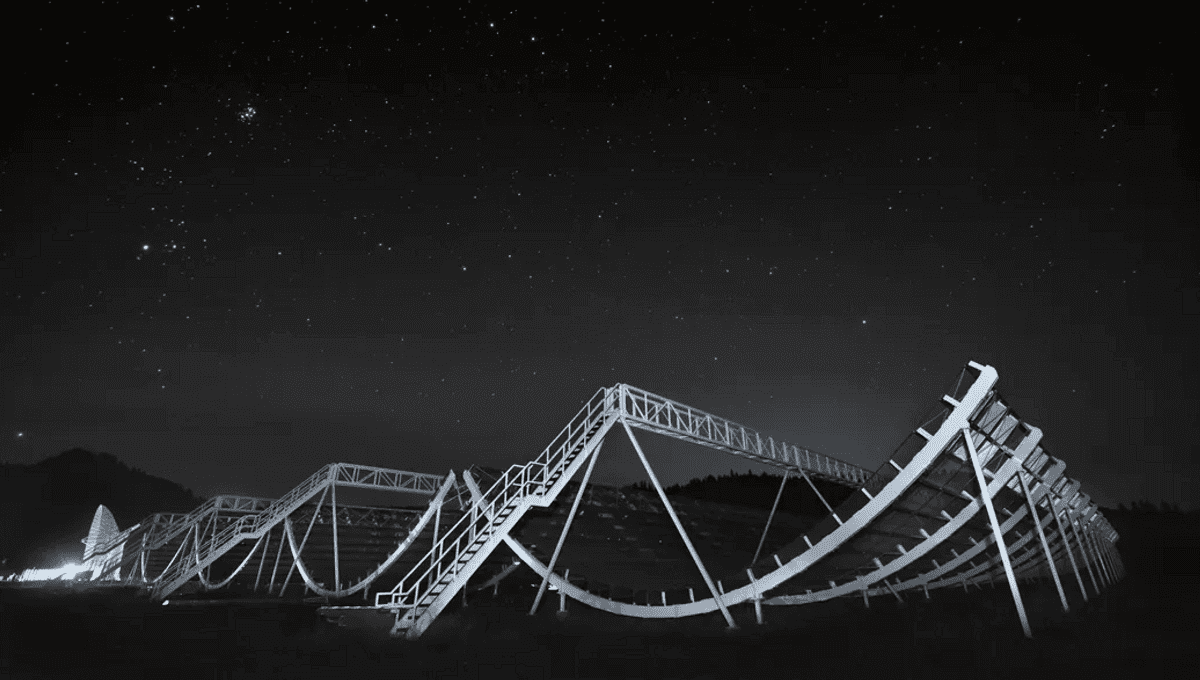
Fast radio bursts (FRBs), incredibly brief but very powerful emissions of radio waves, were only discovered in the last 15 years or so. Their exact cause is a matter of debate; astronomers have discovered some that repeat regularly and others that seem to be a one-off event. Astronomers have now discovered a large number of new repeaters, and their properties – different from previous detections – might be telling us something profound about the nature of all FRBs.
Researchers with the Canadian Hydrogen Intensity Mapping Experiment (CHIME) observatory have more than doubled the number of repeated FRBs spotted by the telescope, adding 25 more to the 21 already known. And, they have 14 more repeating candidates that they hope to follow up in future observations to confirm. CHIME observes the sky using the rotation of the Earth, no moving parts required, so it can pick up these FRBs as they happen. It has so far detected 500 FRBs.
In a new preprint paper, not yet published or peer-reviewed, the team set out to understand if any of those were repeating over the time that the telescope observed, which went from 2019 to 2021. CHIME is good at picking up but it hasn’t got a great resolution, so confirming that two bursts came from the same location in the sky required a robust statistical approach.
Some of the previous repeating FRBs emitted their peculiar signals at specific intervals. This led to the suggestion that they are produced by compact objects, like neutrons stars, orbiting heavier objects. Some neutron stars, known as magnetars, have an incredibly strong magnetic field, and the interactions between the magnetic field of these magnetars and their companions might be responsible for FRBs.
Those FRBs are incredibly active and allowed astronomers to learn a lot about them. The 25 new ones are not as active, and the team is not certain about their detail just yet. The most active source only has 12 bursts, making it really hard to detect a specific periodicity. They plan to continue to observe them and hope that others will do so too.
“We continue to collect data. We try to operate 24/7 year-round and so we will do our own follow-up. But then some parts of the sky we see only for a few minutes every day. So we are not the best suited to do a really long follow-up. And so we hope that other teams in the world will take their telescope and do the follow-up,” corresponding author Dr. Ziggy Pleunis told IFLScience.
Based on the work, the team estimates that at least 2.6 percent of FRBs repeat, but the data collected could suggest that all the FRBs repeat over a long enough time. We just haven’t caught them yet.
“When first repeating FRBs were discovered, we discovered a few very active sources. For some of these, we see multiple bursts per hour. They seem to be really going crazy with their fireworks,” Dr. Pleunis told IFLScience. “But what we’ve now started seeing is there’s also a lot of repeating sources that are sort of slowly repeating. We don’t see a ton of bursts, maybe we see two or three over multiple years.”
“It is possible that there’s some sort of continuum of repeat rates. You have some very active repeating sources and some infrequently repeating sources. And maybe it is possible that everything we see as non-repeating actually is; we just haven’t had the time or the sensitivity yet to see the repeat burst!”
The work has been submitted to The Astrophysical Journal and it can be read on the ArXiv.
Source Link: Astronomers Discover 25 New Fast Radio Bursts Unlike What We Have Seen Before